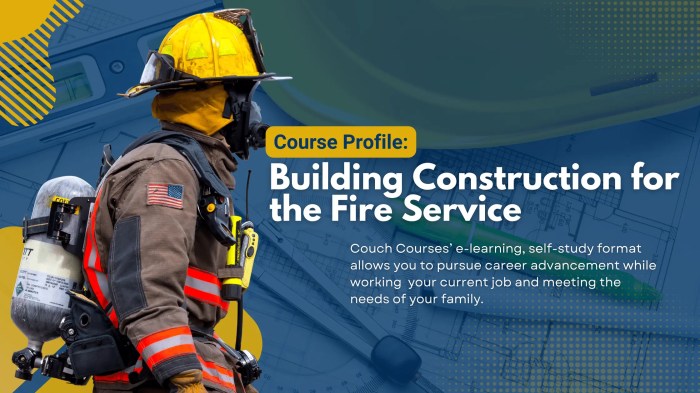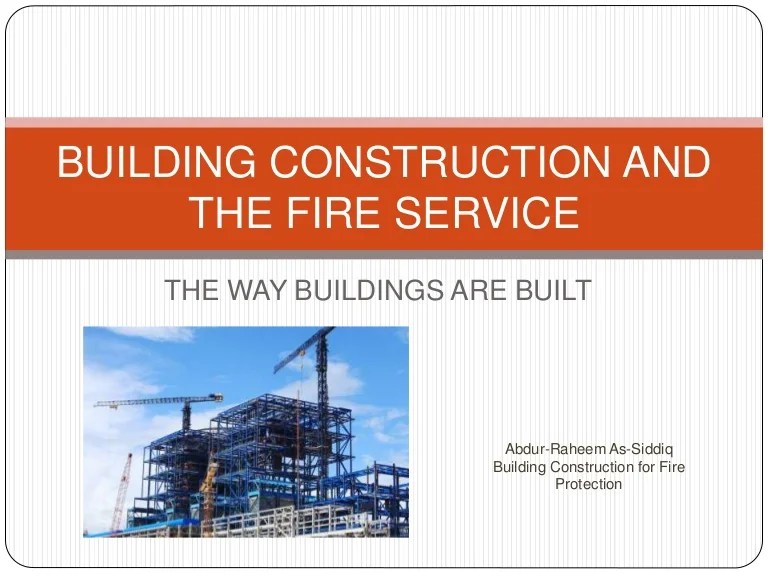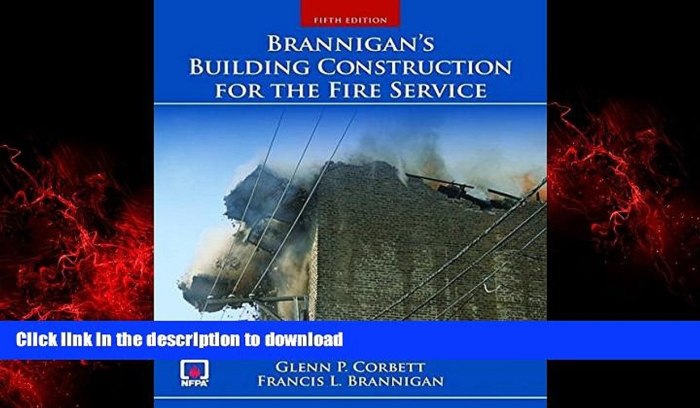Brannigan’s building construction for the fire service 6th edition – Brannigan’s Building Construction for the Fire Service, 6th Edition, is the definitive guide to building construction for firefighters. This comprehensive text provides a thorough understanding of building construction materials, fire behavior in buildings, and firefighting tactics and strategies. With clear and concise language, Brannigan’s Building Construction for the Fire Service, 6th Edition, is an essential resource for firefighters at all levels.
This latest edition has been updated to reflect the latest developments in building construction and fire science. New chapters on special hazards and firefighter safety have been added, and the text has been revised throughout to ensure that it remains the most up-to-date and authoritative source of information on building construction for the fire service.
Building Construction Fundamentals for Fire Service Personnel

Building construction knowledge is crucial for firefighters to understand fire behavior and develop effective firefighting strategies. Different construction materials possess unique properties that influence fire spread, smoke movement, and structural stability.
Understanding these materials helps firefighters anticipate how buildings will react to fire, identify potential hazards, and make informed decisions during firefighting operations.
Types of Building Construction Materials
- Wood:Combustible material with high flame spread and low fire resistance.
- Steel:Non-combustible material with high strength and low thermal conductivity.
- Concrete:Non-combustible material with high thermal mass and fire resistance.
- Masonry:Non-combustible material with high thermal mass and fire resistance.
Impact of Building Construction on Fire Behavior
- Fire Spread:Combustible materials accelerate fire spread, while non-combustible materials resist it.
- Smoke Movement:Building openings and ventilation systems influence smoke movement, affecting visibility and firefighter safety.
- Structural Stability:Fire can weaken building structures, leading to collapse hazards.
Fire Behavior in Buildings: Brannigan’s Building Construction For The Fire Service 6th Edition

Fire behavior in buildings is influenced by several factors, including building construction. Understanding the stages of fire development and how construction materials impact fire spread is essential for firefighters.
Stages of Fire Development
- Incipient Stage:Small, localized fire with limited heat and smoke production.
- Growth Stage:Fire grows rapidly, producing significant heat and smoke.
- Fully Developed Stage:Fire reaches its maximum intensity, consuming all available fuel.
- Decay Stage:Fire begins to decline due to lack of fuel or oxygen.
Influence of Building Construction on Fire Spread
- Compartmentalization:Fire-rated walls and doors limit fire spread to adjacent compartments.
- Ventilation:Openings and ventilation systems provide oxygen for fire growth and facilitate smoke movement.
- Fuel Load:The amount and type of combustible materials present affect fire intensity.
Firefighting Tactics and Strategies

Firefighting tactics and strategies are tailored to specific building construction types. Firefighters must consider the building’s layout, materials, and potential hazards when developing their approach.
Firefighting Tactics
- Offensive:Direct attack on the fire to extinguish it.
- Defensive:Protect life and property by containing the fire and preventing its spread.
- Combination:Combination of offensive and defensive tactics.
Impact of Building Construction on Tactics, Brannigan’s building construction for the fire service 6th edition
- Structural Stability:Weakened structures may limit access or require special tactics.
- Compartmentalization:Firefighters may need to breach fire-rated barriers to gain access or ventilate.
- Fuel Load:High fuel loads may require additional resources or alternative firefighting strategies.
Special Considerations for Firefighters

Firefighters face unique hazards and challenges in building fires. Understanding these hazards and taking appropriate precautions is crucial for their safety and effectiveness.
Special Hazards
- Structural Collapse:Fire can weaken building structures, leading to potential collapse.
- Smoke and Heat:Dense smoke and extreme heat can impair visibility, breathing, and mobility.
- Toxic Gases:Burning materials release toxic gases that can be harmful to firefighters.
Personal Protective Equipment (PPE)
PPE is essential for protecting firefighters from the hazards of building fires. It includes:
- Helmet:Protects head from falling debris and heat.
- Turnout Gear:Fire-resistant clothing that protects from heat and flames.
- Self-Contained Breathing Apparatus (SCBA):Provides breathable air in smoke-filled environments.
Firefighter Training and Education
Comprehensive training and education are vital for firefighters to understand building construction, fire behavior, and firefighting tactics. This training includes:
- Classroom Instruction:Theoretical knowledge and practical exercises.
- Live Fire Training:Controlled burns to simulate real-world fire conditions.
- Continuing Education:Ongoing training to stay updated on new techniques and advancements.
User Queries
What is the importance of building construction knowledge for firefighters?
Building construction knowledge is important for firefighters because it helps them understand how buildings are constructed and how fire behaves in different types of buildings. This knowledge helps firefighters make better decisions about how to fight fires and how to protect themselves and others from harm.
What are the different types of building construction materials and their properties?
The different types of building construction materials include wood, steel, concrete, and masonry. Each type of material has its own unique properties that affect how it behaves in a fire. For example, wood is a combustible material that can burn easily, while steel is a non-combustible material that does not burn.
How can building construction impact fire behavior?
Building construction can impact fire behavior in a number of ways. For example, the type of construction materials used can affect how quickly a fire spreads. The layout of a building can also affect how fire spreads, as well as the presence of fire protection systems.